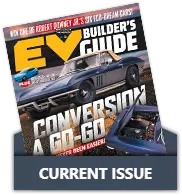DURAMAX VVT SCIENCE
AN INSIDE LOOK AT THE HT TURBO PROMAX 64
The introduction of the Variable Vane Turbocharger (VVT) on the LLY GM Duramax in 2004 may have been mostly emissions-control related, but in the years since, it has proven to be a solid performer with great power potential—with a few tweaks from the aftermarket. The Garrett VVT used on the 2004.5-2016 Duramax has gone through a few revisions with each engine platform, but it remains a pretty solid turbocharger for daily driving, towing, and power output up to around 530 horsepower.


But as with anything else, the aftermarket always finds ways to improve performance, and the VVT turbo is no different. High Tech Turbo of Salt Lake City has specialized in everything turbo since 1985 and has been modifying the OEM Duramax turbochargers for quite a few years with great success. The ProMax 64 will support up to 600 rear-wheel horsepower and can reduce exhaust back-pressure and EGTs for daily driving and towing applications. It also bolts directly in place of the stock unit, with no other changes necessary.


When GM started looking for ways to reduce emissions in the 6.6L Duramax engine, the variable geometry turbocharger helped immensely. By allowing quick low-rpm response, the VVT can better control smoke output at low boost, all while creating higher back-pressure in the exhaust stream to force exhaust gases through the Exhaust Gas Re-circulation (EGR) system. Keeping the exhaust vanes closed makes it feel like a small turbocharger with good response. But opening those vanes up so the exhaust can flow freely gives it the feel of a larger turbocharger for better power and temperature control, to a certain point at least. Running low 500 hp tunes, most owners will see extreme EGTs and excessive drive pressure numbers at wide open throttle. The compressor wheel just won’t move enough air and the restrictive turbine side becomes a choke point and limitation to safely making more power. To overcome this, HT Turbo upgrades both the compressor and turbine wheel with larger, high-flowing wheels that are better suited for the 400-600 hp crowd.



On the compressor side of the LLY and LBZ turbochargers, the stock 11-blade wheel is replaced with a 63 mm billet 6-blade wheel that will increase volume at similar boost pressures. This wheel design offers better flow and engine efficiency in the mid-range for better power and EGT control. Of course, the compressor covers are machined to accept the larger compressor wheel. On the exhaust side, the factory 12-blade turbine wheels are replaced with a 10-blade pro wheel, which will better handle the exhaust flow being created within the engine at the higher horsepower levels. The change to a larger-diameter 10-blade wheel will reduce drive pressure without affecting spool-up. In most cases, a minor tuning adjustment within the vane control tables can make this turbocharger drive almost like stock, until you hammer on it and really feel that broader torque curve from the major jump in air flow.


Along with their custom machining and wheel upgrades, HT Turbo also upgrades some of the internal pieces, such as changing to a 360-degree thrust bearing to better handle the stress and added load the turbo may see at higher boost levels. Each charger is cleaned, inspected and closely measured to ensure the new bearings and seals will be within OEM specifications. The rotating assemblies are also fully balanced on high speed balancers so that premature bearing failure can be avoided.




bores measured to make sure the proper bearing tolerances are
maintained.

If there is one common flaw within the Garrett VVT design, sticking vanes or a failed unison ring, which controls the exhaust vanes, is the most likely culprit if you experience intermittent response and driving issues from the OEM VVT unit. On high-mileage trucks that have seen a lot of soot and exhaust build-up over time, any small moving part, like those vanes, could see some wear. Unfortunately, these issues are just the nature of the beast within any variable geometry turbo. Of course, all these pieces are fully cleaned and inspected before assembly of a new ProMax 64 to be sure everything will work as it should once installed on a customer’s truck.


Speaking with Braydon Price of Meridian, Idaho, who recently installed the ProMax 64 on his mildly built LBZ truck, we were able to get firsthand feedback on his modified VVT. He had been looking to improve peak horsepower in his Max Effort tunes, while reducing EGT towing in his lower horsepower tunes. Price works as a sales rep at Adrenaline Truck Performance (ATP Trucks), so he knows a bit about these trucks and what it takes to really dial one in. With a cold-air intake, 4-inch exhaust, lift pump, and a built Allison transmission, the truck made 512 hp in his Max Effort tune with the stock turbocharger. Swapping over to the High Tech Turbo ProMax 64, the peak output jumped to 574 hp, an increase of 62 horses with no other changes to the truck. Best of all, the pyrometer gauge has shown drops of nearly 150 degrees at wide open throttle, and he’s also reported it being much easier to control EGTs while towing heavy in tunes that make 400 hp.


The crew at High Tech have seen trucks running mild injector upgrades and healthy CP3s make more than 600 hp with this turbo with near stock driving characteristics. The ProMax 64 is currently available for the LLY and LBZ platforms, but a direct bolt-in upgrade is nearing release for the LMM and LML trucks as well. For those of you looking to maintain all the factory emissions equipment (DPF, Urea, EGR), the aftermarket is catching up, and any of these turbos should be a great upgrade for improving airflow to that big Duramax engine, regardless of the model year.













